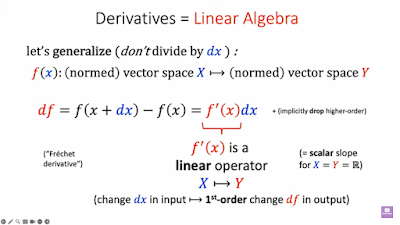Alan Kay on Simplicity
He starts out talking about Higher Education and goes on to talk about Corporations and how hard it is to produce scalable solutions to problems, ... I'm only half way through though. I hope he doesn't stop at computing, ...
I am amazed at how hard it was to figure out what software I needed to create this PDF page:
The languages are English, Greek, mathematics, SVG and Standard ML. The problem is the number of different pieces of concrete software involved. These are all fairly well-defined languages, but there is no software that actually knows what languages are in general, and how they can be translated one into another.
At 41:30 he lost me completely. I didn't know what HANA is, I had to look it up. I think what he's saying is that by choosing what you "buy your way into" at the beginning, you have some control over what kinds of economic development happen in the future. Maybe this explains the comment at 36:44 about businesses not being allowed to write-off R&D costs but being allowed to write off computers as if they were consumables.
Subscribe to Kenneth Friedman.
Here's a more recent talk (2021) where he mentions McCarthy's A basis for a mathematical theory of computation, preliminary report (1961):
Programs that learn to modify their own behaviors require a way of representing algorithms so that interesting properties and interesting transformations of algorithms are simply represented. Theories of computability have been based on Turing machines, recursive functions of integers and computer programs. Each of these has artificialities which make it difficult to manipulate algorithms or to prove things about them. The present paper presents a formalism based on conditional forms and recursive functions whereby the functions computable in terms of certain base functions can be simply expressed. We also describe some of the formal properties of conditional forms, and a method called recursion induction for proving facts about algorithms.
43:26 "As you scale up you have to go from types of things to descriptions of behaviours" ... See Linda (coordination language) which looks like a half-assed version of π-calculus. According to the π-calculus FAQ there is a language called Sharpie by Jim Larus, Sriram Rajamani, and Jakob Rehof that has a semantics based on π-calculus. Good luck if you expect Google to tell you anything about it. Sriram Rajamani is Corporate Vice President, Microsoft Research. The reference given is Jim Larus, Sriram Rajamani, and Jakob Rehof, Behavioral Types of Asynchronous Programming, Microsoft Research Technical Report, November 2002, submitted to PLDI. http://www.research.microsoft.com/behave/sharpie-report-abs.html.
47:22 How not to make progress.
54:22 On user interface design: Bret Victor's web page: https://worrydream.com/cv/ See also https://dynamicland.org/:
Subscribe to Chariot Solutions.
Bret Victor's 2013 talk on representation:
That Nile viewer is still online: http://tinlizzie.org/dbjr/high_contrast.html
Subscribe to Colin Reckons.
Talk for students at UCLA given in February 2024
To save you typing, see Douglas Engelbart and The Mother of All Demos.
44:50 The TX-2 Computer Graphics Display (1958). See The TX-2 Computer and Sketchpad.
1:29:57 On the politics of education in the USA and the UK. It's worse in the UK.
See also Alan Kay's Quora posts.
Subscribe to Yoshiki Ohshima.
Ivan Sutherland demonstrating Sketchpad (1962):
Subscribe to Interface Studies.
The Mother of All Demos film (1968):
46:50 The whole system was written in a metalanguage for writing compilers.
1:13:03 They had screen-sharing and two-way audio-visual links in 1968.
1:29:48 He describes a progenitor (more general) of the Google PageRank idea.
Subscribe to fschnell.
Alan Kay demonstrating Etoys, a progenitor of Scratch in 2013:
His 2003 Turing Award lecture is with slides is available here: https://tinlizzie.org/IA/index.php/Alan_Kay_Turing_Award_Lecture_(2004).
Subscribe to Every Alan Kay Video.
Alan Kay interviewed in 2013
Subscribe to Kenneth Friedman.
So how we manage all this channel-switching machinery? See What is a user interface supposed to do?
Rendering Text: the knowledge is out there, and each of us has to learn it and make or find some concrete implementation:
See Behdad Esfahbod's document State of Text Rendering 2024.
Subscribe to VoxelRifts.
So we have this display technology, (CRT Oscilloscopes) and we have wave table synthesis, and data compression and DACs that can do DC output, so we have Jerobeam Fenderson - N-Spheres:
Subscribe to Jerobeam Fenderson.
Intel 64 Bit instruction encoding:
Subscribe to Phil Hatcher.
Alan Kay on Programming and Scaling (Talk given in Potsdam on July 21, 2011)
49:47 Doing 2D graphics on a personal computer. See http://vpri.org/, https://raw.githubusercontent.com/wiki/damelang/nile/socal.pdf and https://en.wikipedia.org/wiki/OMeta.
Subscribe to Colin Reckons.



Comments
Post a Comment